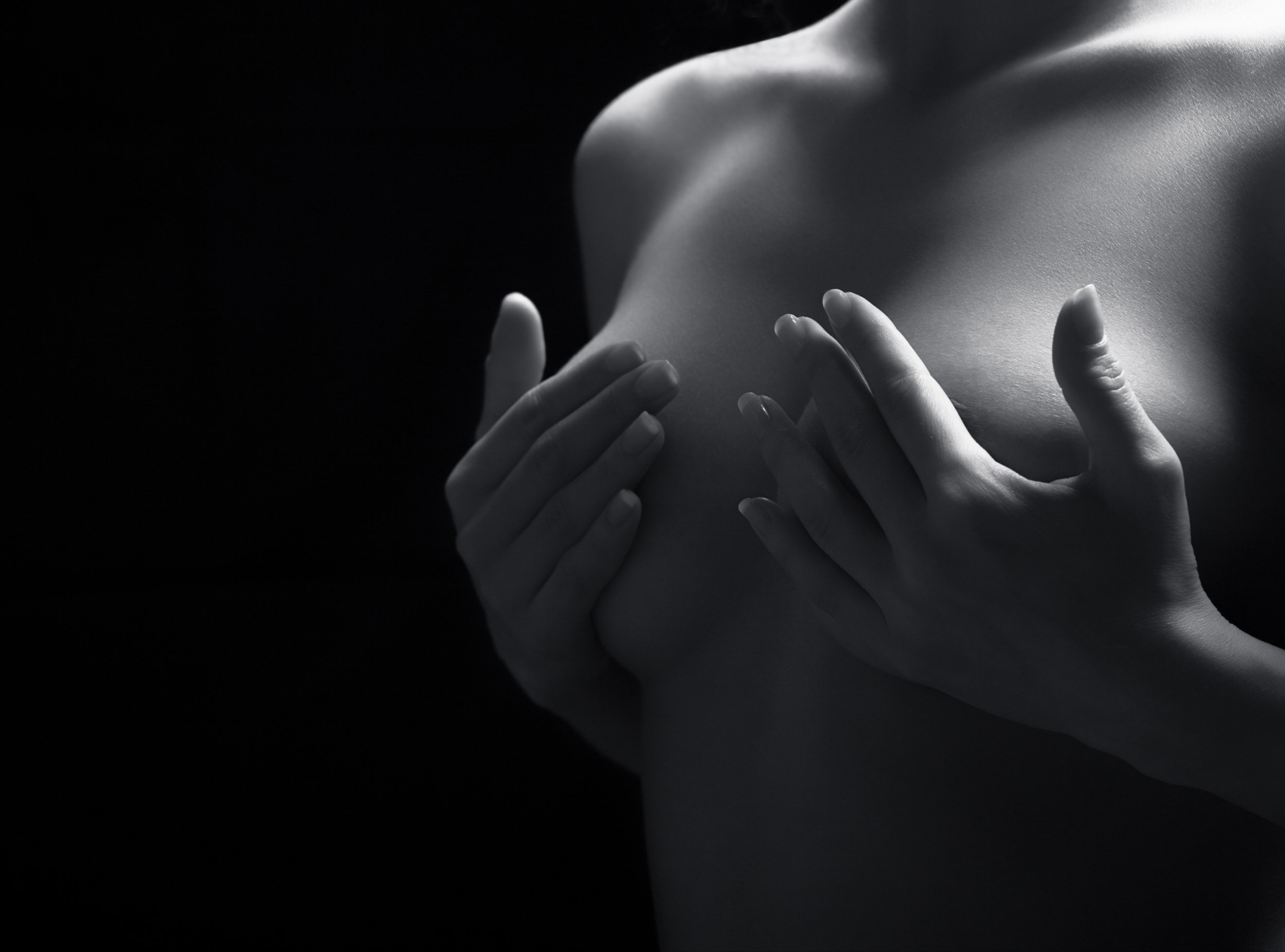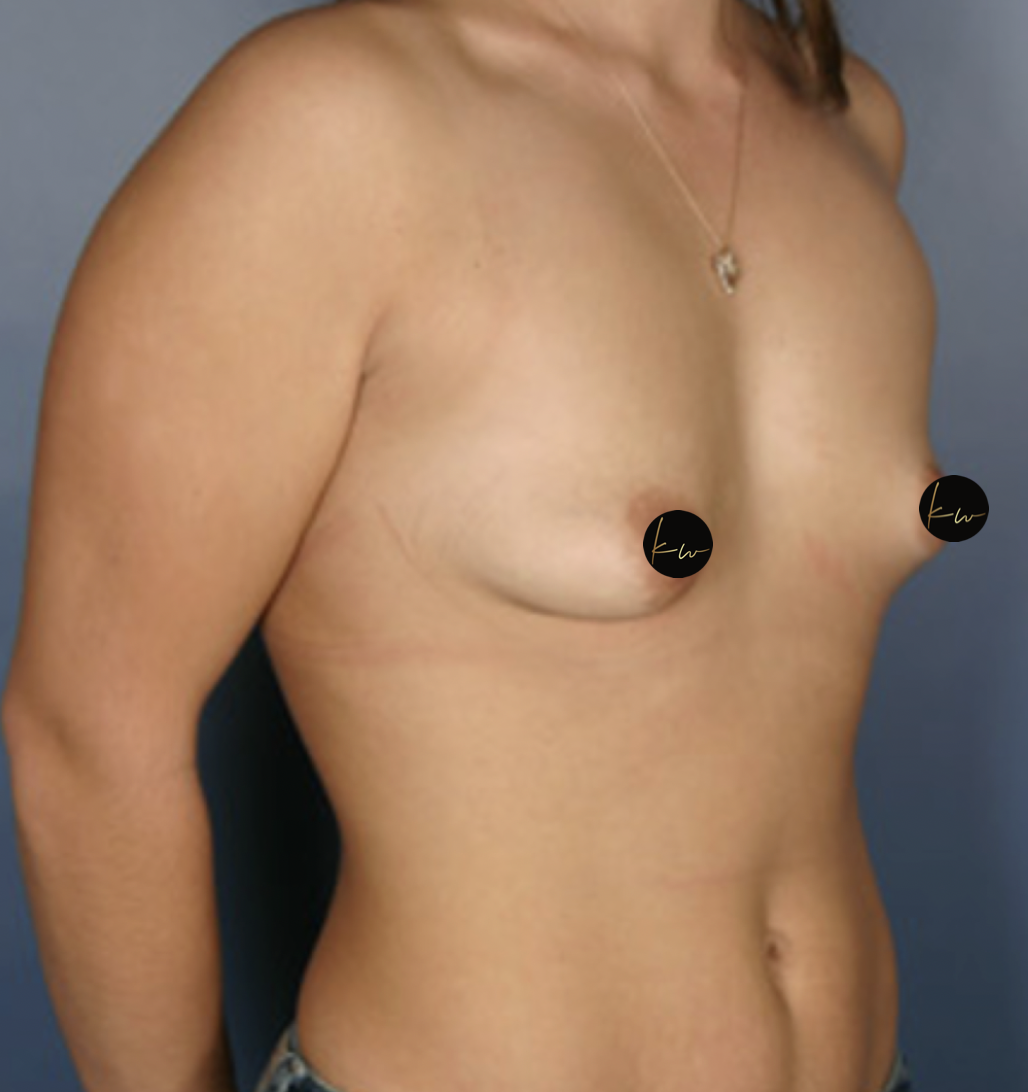Tuberous breasts
Expand that lower pole
If you notice that the lower pole of your breasts is not well developed after puberty or that you have an overall reduced breast development with a tubular aspect, you may be diagnosed with tuberous breast formation. It is important to know that this is nothing dangerous or malignant, but merely the result of a maldevelopment within the breast parenchyma or breast tissue. A constricting ring of dense, fibrous tissue is formed around the nipple-areolar complex, which inhibits a normal development of the breast. The good news is that there is a very elegant surgical technique that enables me to give you an enhanced shape, projection, and volume of your breasts. And it only required one incision.
The essentials
Tuberous breast development is a malformation of normal breast tissue caused by an abnormal constricting ring of fibrous tissue.
Typical symptoms of a tuberous breast are: a smaller breast contour - a shorter aspect of the breast - limited breast volume - a partially or complete absent lower breast pole - an elevated inframammary fold - a tubular aspect of the breast with herniated aspect of the nipple-areola complex - enlarged areola
Tuberous breast surgery involves the correction of all the mentioned issues to restore a normal breast shape, volume and projection.
In most cases, an incision around the areola suffices to perform the complete surgery.
An implant is often needed to compensate for the restricted volume.
Consider a 2-week downtime with easy wound care. Avoid physical activity for 6 weeks.
Respect the recovery time well and you will profit from the transformation for the rest of your life.
What are tuberous breasts ?
The development of a female breasts begins very early, around the 5th embryological week. When you are born, all the elements of a breast have already been formed: the breast parenchyma (or tissue) will generate the lobules and nipple-areolar complex. And within the parenchyma, small tunnels appear that will evolve into the milk ducts that are needed for breast feeding at a later stage in your life.
It is only when puberty starts, that the breast tissue increases in volume. In a normal developing breast, the gland is contained within two anatomical layers of fascia (strong connective tissue). These layers of fascia help to form the typical cone shape of a breast and well-defined inframammary fold. However, in case of tuberous breasts, there is an extra ring of fibrous tissue that is formed around the nipple-areolar complex (under the skin) that inhibits normal breast development. This constricting ring will lead to an overall smaller shape and volume of the breast and can also influence the overall aesthetics of the breast. It can develop in one or both breasts and often leads to the following visual characteristics:
A constricted breast base: the overall contour of the breast is smaller
A contracted skin envelope: both the height and width of the breast are shorter
Hypoplasia of the breast parenchyma: the volume of the breast tissue is limited. In most cases, there is an underdeveloped lower pole (the tissue below the nipple is less developed), but sometimes there is an overall reduced size of the breast tissue
Elevated inframammary fold: the fold below your breast sits higher on your chest wall and makes the breast also look shorter
A short nipple to inframammary fold distance: the distance from your nipple to the fold below the breast is shorter than usual. In a normal developed breast, this distance is around 7cm. In a tuberous breast this can be as little as 3 to 4cm.
Herniation of the breast parenchyma into the nipple-areolar complex: the breast tissue is pushed through the constricting ring, which gives a tubular aspect of the breast and areola. There is no smooth transition from the breast skin to the areola.
Hypertrophy of the areola: in most cases, the areola is larger than usual.
In a tuberous breast, a constricting ring inhibits normal breast development, resulting in a constricted breast. There are different degrees of tuberous breasts, depending on the anatomy of the constricting ring.
A typical presentation of tuberous breasts with an underdeveloped lower pole, elevated fold and breast hypoplasia.
How can we correct tuberous breasts ?
In order to transform your breast from a small, tubular, and constricted shape into a beautiful, teardrop breast with enhanced volume and projection, I have several surgical goals:
I want to restore your breast volume
I want to make the overall breast contour larger
I want to expand your lower pole and create a convex shape with a well-defined infra-mammary fold
I want to reduce the size of your areola
I want to place your breast fold lower on the chest, in a more natural position
I want to correct the herniation of your breast tissue and get rid of the tubular aspect
I want to give you the most symmetric breasts possible
I want to use the least amount of incisions as possible
As you can see, there is a lot of work to be done. I was fortunate enough to be trained in a center that is world-renowned for this type of procedure. So I am confident that I have the necessary experience and knowledge to give you a huge improvement in your breast aesthetics. The second good news, is that in most cases, I am able to perform the whole surgery through one incision. I need one incision around your areola to achieve all the surgical goals I mentioned before: I reshape the gland, increase the volume, correct your infra-mammary fold, expand your skin and reduce the areola size. In the end, you will have a fine line right at the border of your areola. This usually heals very nice. The pre-operative design is very specific to each breast. I apply a very patient-tailored approach for this type of surgery.
It is important to know that in most cases, I will be using an implant to correct the breast volume and improve the projection. There is usually not enough breast tissue to give you the breast aesthetics that you desire. Read all about breast implants here. The combination of the advanced surgical techniques, meticulous closure, and a well-suited breast implant can truly bring an enormous transformation to your breast and your life. During the consultation, I will explain to you the procedure in more detail, with pictures and photographs, as well as which scars to expect and the post-operative care that will be needed. You can expect a down time of 2 weeks, with light dressings.
What are the benefits of a tuberous breast correction ?
The breast is one of the most important external identifications of femininity. An underdeveloped or maldeveloped breast can have a huge psychological impact on a woman. Tuberous breasts may make you feel insecure or undesirable. It is my job to get rid of those body image concerns and make you feel more like a woman again. The correction of tuberous breasts is an extremely rewarding surgery, not only thanks to the elegant surgical techniques that are required, but also because of the enormous positive impact it brings to a woman's well-being. It is one of those surgeries that really changes a woman's life for the better. It therefor has a lot of benefits:
Enhanced shape, volume and projection of the breasts
Restored proportions with a correct position and size of the nipple-areolar complex
Restoration of the key characteristics of an aesthetic breast
Improved breast symmetry
Improved inner breast volume (cleavage)
Enormous positive impact on your well-being and femininity
Life-changing effect on your self-consciousness
A boost in your self-confidence
Are you a good candidate for tuberous breast correction ?
If you recognise one or more symptoms or clinical signs that I mentioned before, you may have tuberous breasts that will benefit from surgery. In most cases, this presents itself at the end of your puberty. Most patients are therefor between 20 and 30 years old. A thorough clinical investigation is of course necessary to see if we are dealing with tuberous breasts. It requires enough expertise and knowledge to make a difference between an overal smaller breast volume versus a tuberous breast. Both surgeries are also completely different. Although correcting tuberous breasts involves performing a breast augmentation as well, there are many more surgical aspects to this treatment. The following clinical signs may point towards tuberous breast development:
There is missing volume in the lower part of the breast
One breast is clearly smaller than the other and sits higher on your chest wall
One or both breasts has an overall smaller contour, both in height and width
Your breast has a tubular shape and there is no smooth transition between breast skin and areola
The areola is enlarged and looks herniated
You experience these signs since puberty
If you recognise some of these signs, I recommend you to plan a consultation in order to see how we can improve your breast aesthetics and bring a positive impact to your life.












